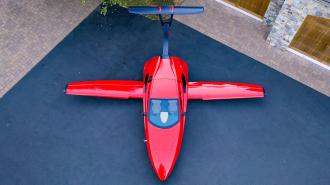A flying sports car has just been cleared for flight by the Federal Aviation Administration (FAA) — but to get behind the wheel of one, you’ll need to build it yourself.
Samson Switchblade: Unlike the eVTOLs expected to one day ferry us across cities like airborne Ubers, Samson Sky’s Switchblade is designed to be a true flying car, capable of both flight and on-road driving.
The idea is that an owner will be able to store the vehicle in their garage and then drive to a local airport. With the push of a button, the car’s wings will swing out from under its cabin, while a tail unfolds from the rear — a process that takes just three minutes.
The owner will then be able to fly the hybrid gas/electric vehicle to another airport, transition it back into car mode, and drive right off the runway to their final destination.
Samson has more than 1,670 reservations for its $150,000+ flying sports car.
What’s new: Before any of that can happen, though, Samson needs to actually get its flying sports car in the air.
On July 28 — more than 14 years after development began on the Switchblade — the company announced that its prototype had passed an FAA inspection needed to be registered as an Experimental Aircraft.
That cleared Samson to finally begin flight testing. CEO Sam Bousfield told the Hill that he now expects to see people flying Switchblades in just a few more years.
The specs: The Switchblade has two seats and just three wheels. It will require a driver’s license to operate in car mode, but you will need a private pilot license to fly it.
The Switchblade can reach speeds in excess of 125 mph on the ground and 200 mph in the air, according to Samson. It will require a 1,100 foot long runway to take off and will have a 450-mile range in the air.
Customers will need to spend approximately 2,000 hours assembling their Switchblade.
DIY flying car: Samson has already received 1,670 reservations for the Switchblade, which has an estimated base price of $150,000. That money won’t get anyone a fully assembled flying sports car, though — instead, Samson will be delivering Switchblade kits.
Customers will then need to spend approximately 2,000 hours assembling the vehicle themselves or pay an estimated $20,000 to have experts at a Samson “Builder Assist Center” help them out — that should cut their build time down to one week of full-time work.
All that matters is that the owner does 51% of the assembly work themselves — this is so the vehicle will qualify for registration as an Experimental Aircraft with the FAA.
The big picture: The Switchblade’s high cost, DIY assembly, and pilot’s license requirement all indicate the flying sports car is more likely to be a fun second (or third) vehicle for members of the upper class than something the average person will ever own.
Still, the company says it does plan to eventually release a fully certified version of the aircraft. That would allow an owner to carry paying passengers in it, so perhaps we’ll one day see Switchblades providing on-demand flights alongside those in-development eVTOLS.
We’d love to hear from you! If you have a comment about this article or if you have a tip for a future Freethink story, please email us at [email protected].




